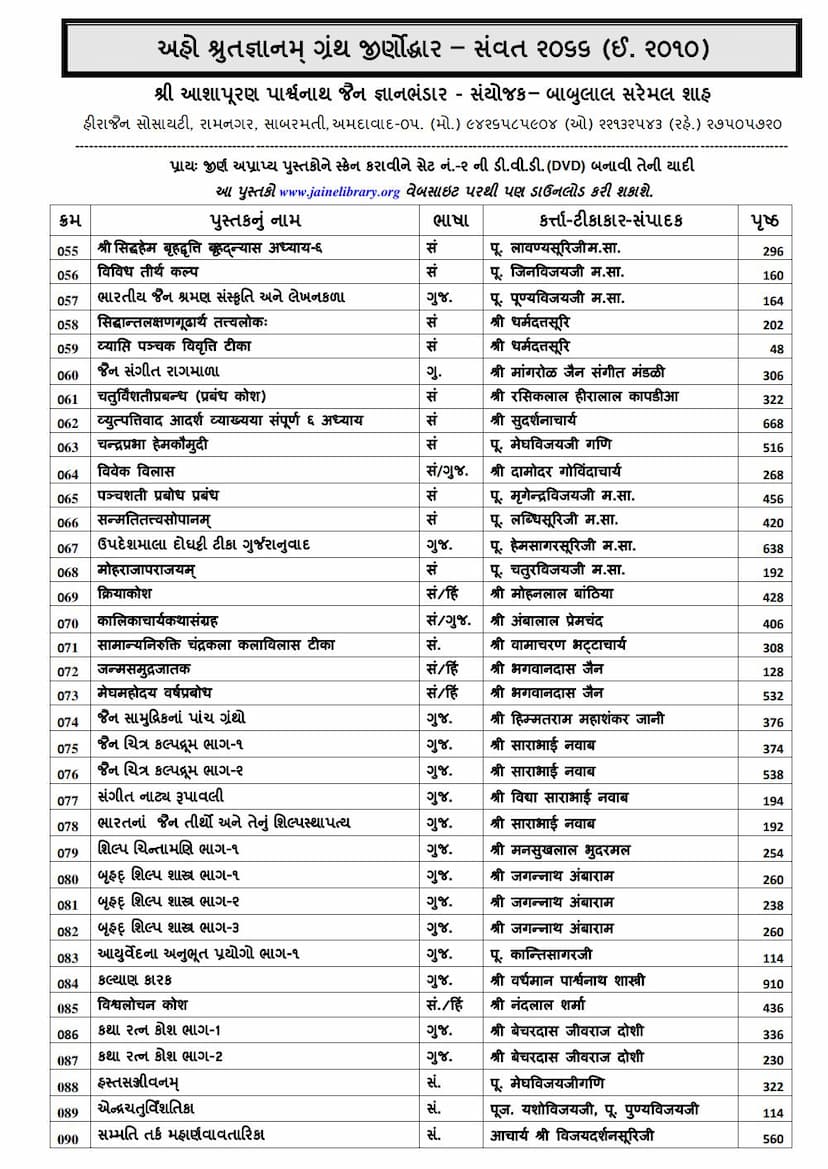Chaturvinshatiprabandha
Added to library: September 1, 2025

Summary
This is a comprehensive summary of the Jain text "Chaturvinshatiprabandha" by Rajshekharsuri, edited by Hiralal R. Kapadia, based on the provided text snippets. The summary focuses on the content, structure, and significance of the work.
Book Title: Chaturvinshatiprabandha (also referred to as Prabandhakos'a) Author: Sri Rajasekhara Suri Editor: Prof. Hiralal Rasikdas Kapadia Publisher: Sri Forbes Gujarati Sabha, Bombay Publication Year: 1932 AD
Overall Summary:
The Chaturvinshatiprabandha, or Prabandhakosha, is a significant Sanskrit work by the Jain author Sri Rajasekhara Suri. It comprises a collection of 24 prabandhas (narratives or accounts), primarily focusing on the lives and teachings of prominent Jain monks, scholars, kings, and influential lay figures. The work serves as a valuable source for the history of Gujarat and Jainism, offering insights into religious practices, philosophical concepts, social customs, and the cultural milieu of ancient and medieval India.
The "Foreword" highlights the importance of this work as material for the history of Gujarat. It notes that the edition is based on three manuscripts and a printed copy, offering various readings, Sanskrit renderings of Prakrit and old Gujarati verses, and appendices that aid in research, such as an index of rulers and cities. The editor, Prof. H. R. Kapadia, is commended for his meticulous work. The foreword also mentions that a critical edition of the Gujarati translation is also in press, which will further elaborate on the author's life and the historical basis of the prabandhas.
Structure and Content:
The book is structured into:
- Foreword: Providing context and acknowledgments.
- A Brief Introduction (Kincit Prastavikam): Offering preliminary remarks about the work.
- The Main Text (Sri Chaturvinshatiprabandha): Containing the 24 prabandhas.
- Appendices (Parishishtani): Including indexes, glossaries, and supplementary information.
The 24 prabandhas themselves cover a diverse range of individuals and events, categorized as follows:
- Monastic Prabandhas (Suri Prabandhas): Ten accounts focusing on prominent Jain monks and acharyas, detailing their lives, erudition, miracles, and contributions to Jain literature and philosophy. Examples from the Table of Contents include:
- Shri Bhadrabahu-Varaha Prabandha
- Shri Aryandila Suri Prabandha
- Shri Jiyadev Suri Prabandha
- Shri Aryakhatacharya Prabandha
- Shri Padalipta Suri Prabandha
- Shri Vriddhavadi-Siddhasena Prabandha
- Shri Mallavadi Suri Prabandha
- Shri Haribhadra Suri Prabandha
- Shri Vappabhatta Suri Prabandha
- Shri Hemchandra Suri Prabandha
- Royal Prabandhas (Raja Prabandhas): Seven accounts focusing on kings and rulers, often highlighting their patronage of Jainism or their interactions with Jain ascetics. Examples include:
- Shri Harsavidyadhara-Jayantachandra Prabandha
- Harishara Prabandha
- Shri Amarachandra Suri Prabandha
- Shri Madanakirti Prabandha
- Shri Satavahana Prabandha
- Shri Vakakchula Prabandha
- Shri Vikramaditya Prabandha (with a separate section "Vikramacharitam")
- Lay Disciple Prabandhas (Rajanga Shravaka Prabandhas): Three accounts focusing on prominent lay Jain followers and patrons, illustrating their devotion, generosity, and adherence to Jain principles. Examples include:
- Shri Lakshyasena Prabandha
- Shri Madanavarma Prabandha
- Shri Ratna Prabandha
- Shri Abhada Prabandha
- Shri Vastupala Prabandha (This seems to be the 24th prabandha, aligning with the title's implication of 24).
Key Themes and Features:
- Biographical Narratives: The core of the work consists of detailed biographical accounts, often including anecdotes, miracles, and significant events in the lives of the subjects.
- Jain Philosophy and Practice: The prabandhas often illustrate core Jain tenets such as ahimsa (non-violence), karma, asceticism, the importance of scriptural knowledge (shruta), and the pursuit of liberation (moksha).
- Historical and Cultural Insights: The text provides glimpses into the political landscape, royal courts, social structures, and religious activities of the time. The mention of various kings, cities, and dynasties contributes to historical understanding.
- Literary Style: Rajasekhara Suri's writing is characterized by its rich Sanskrit, use of various meters, and engaging narrative style. The editor notes the inclusion of Sanskrit renderings of Prakrit and old Gujarati verses, indicating a synthesis of linguistic traditions. The text also incorporates legal and ethical principles through various aphorisms and examples.
- Author's Lineage and Scholarship: The introduction provides details about Rajasekhara Suri's lineage within the Jain tradition, including his gaccha (sect) and gurus, and references his other works, such as the Shatdarshana Samucchaya.
Significance:
The Chaturvinshatiprabandha is a foundational text for understanding the history and development of Jainism, particularly in Gujarat. It preserves the stories of individuals who played crucial roles in shaping the religion and its societal influence. The meticulous editing by Prof. Kapadia ensures its accessibility and value for scholarly research, making it an indispensable resource for anyone studying Jain history, literature, and culture. The detailed appendices further enhance its utility for academic purposes.